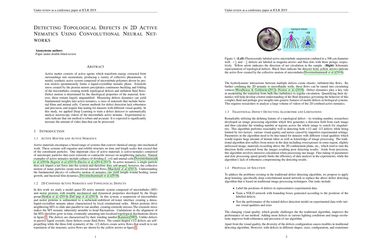Detecting Topological Defects in 2D Active Nematics Using Convolutional Neural Networks
Active matter consists of active agents which transform energy extracted from surroundings into momentum, producing a variety of collective phenomena. A model, synthetic active system composed of microtubule polymers driven by protein motors spontaneously forms a liquid-crystalline nematic phase. Extensile stress created by the protein motors precipitates continuous buckling and folding of the microtubules creating motile topological defects and turbulent fluid flows. Defect motion is determined by the rheological properties of the material; however, these remain largely unquantified. Measuring defects dynamics can yield fundamental insights into active nematics, a class of materials that include bacterial films and animal cells. Current methods for defect detection lack robustness and precision, and require fine-tuning for datasets with different visual quality. In this study, we applied Deep Learning to train a defect detector to automatically analyze microscopy videos of the microtubule active nematic. Experimental results indicate that our method is robust and accurate. It is expected to significantly increase the amount of video data that can be processed.
PDF Abstract
